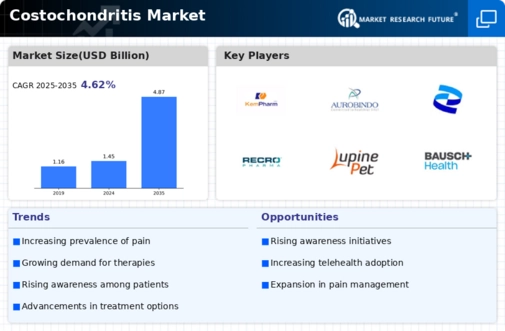Drivers
Rheumatoid Arthritis is among the most common variables that contribute to the development of costochondritis (RA). According to research, 41 out of every 100,000 people diagnosed have RA every year, with females being 2-3 considerably more probable than males to have the disease. Due to the rise in RA cases, the number of individuals confirmed with costochondritis has grown, which is a primary driver for expanding the worldwide costochondritis market growth in recent years.
Opportunities
It is expected that the costochondritis market would benefit from the increasing number of people living with arthritis during the forecast timeframe.
Restraints
Although factors like the heavy price of surgeries performed, the expense of therapies and the side effects associated with treatments are likely to restrain market development during the projection period, there is still room for expansion.
Challenges
Despite the high prices of operations and therapies, the harmful side effects of these therapies are preventing this industry from expanding internationally.
Cumulative Growth Analysis
North America is the most critical contributor to the development of the worldwide market for costochondritis. According to estimates, over 24 per cent of individuals in the United States have been identified with rheumatoid, as well as the rate of instances of TB is also on the increase. These are the most critical drivers driving the development of the costochondritis industry in North America, and particularly in the United States of America. Europe is seeing a surge in the number of people suffering from hypertensive diseases, which is fueling the expansion of the global costochondritis market in the region.
Value Chain Analysis
According to the reports, the worldwide costochondritis market is categorized on the basis of diagnostic, therapy, end-user, and regions. The costochondritis market may be divided into many categories based on the diagnosis. It is subdivided into the following tests: cardiac magnetic resonance imaging (MRI), cardiac catheterization, chest X-ray, echocardiography, EKG, stress tests, and CT scan. The market is divided into three categories based on the kind of treatment: therapy, drugs, and surgery.
Antidepressants, Nonsteroidal anti-inflammatory medicines (NSAIDs), opioids, and anti-seizure medications are all included in the pharmaceutical therapy category. Workouts and neural stimulation are two types of therapy that are offered. The market is categorized based on the end-user, with research centres, hospitals and clinics, diagnostic centres, ambulatory surgery centres, and others being the most common categories.
Region-wise, the worldwide costochondritis global market is subdivided into four regions: the Americas; Europe; Asia Pacific; the Middle East and Africa; and South and Southeast Asia. The Americas are further subdivided into two groups: North America and South America. The North American area is further divided into two parts: the United States and Canada. The European continent is separated into two parts: Western Europe and Eastern Europe. Western Europe is the more developed of the two. Western Europe is further subdivided into the countries of Germany, France, Italy, the United Kingdom, Spain, and the rest of Europe.
Subdivided into India, Japan, Australia, China, the Republic of Korea and the rest of Asia-Pacific, the Asia-Pacific region is divided into five subregions. The Middle Eastern and African area is further subdivided into the United Arab Emirates, Kuwait, Qatar, Saudi Arabia, Oman, and the remainder of the Middle East and Africa, as shown in the diagram.
The rising prevalence of musculoskeletal disorders, including costochondritis, underscores the urgent need for enhanced diagnostic and therapeutic strategies in the healthcare system.
Centers for Disease Control and Prevention (CDC)


















Leave a Comment